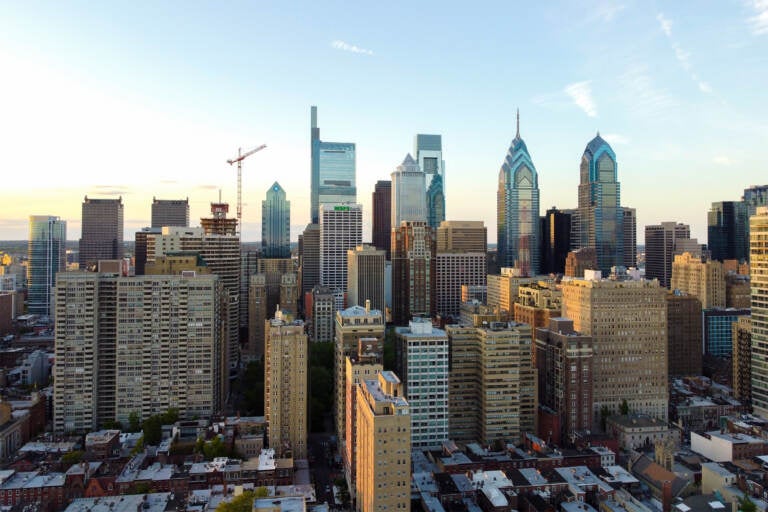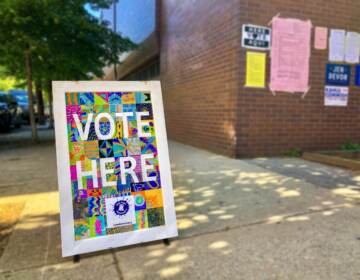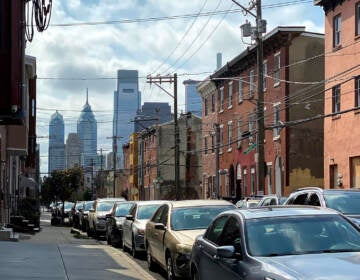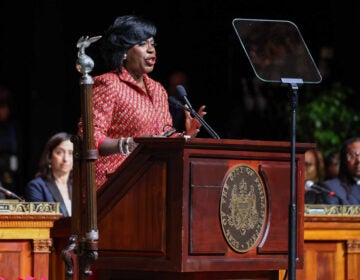A snapshot of Philly’s economy: What will the next leaders inherit?
Last time Philly elected a new mayor, the economy was recovering from a recession. Now that new leaders are poised to take over, experts weigh in on the future of the city.
Listen 1:44
Philadelphia skyline, May 2021. (Mark Henninger/Imagic Digital)
It’s been about eight years since Philadelphia voters elected a new mayor. Back then, the regional economy was still recovering from the Great Recession and the city’s population was growing.
In 2019, before Mayor Jim Kenney was reelected, the regional economy was again on an upswing.
In 2020, the coronavirus pandemic pushed the global economy into a tailspin with massive unemployment, government-mandated shutdowns followed by major federal stimulus packages, labor shortages, manufacturing delays, and record inflation.
Now, as voters head to the polls on Tuesday, the regional economy has mostly recovered again but some things won’t likely return, such as office workers flocking to Center City.
“It would be hard for me to imagine that we will completely go back to where [the economy] was in 2019, just because people’s habits have changed in the past three years,” said Ryo Tashiro, senior outreach economist for the Federal Reserve Bank of Philadelphia.
The regional economy could slow down in 2024 when new leaders take the helm of city government.
“Economic activities are slowing down at the regional and at the national level. Six months from now, labor markets will continue slowing down,” Tashiro said. “So the economic conditions will probably be a little bit worse.”
But in general, the Philadelphia economy has bounced back since the pandemic. For example, in March 2015 the Philadelphia-Camden-Wilmington metro area unemployment rate was 5.7%. In March 2019, the regional unemployment rate improved to 4%. During the height of the coronavirus pandemic, unemployment was in the double digits hitting 16% in April 2020. Since then it has slid down to 3.8% as of March 2023.
“Most sectors have actually completely recovered from jobs lost from the pandemic,” Tashiro said. “The only two sectors in the region that have still yet to fully recover are the leisure and hospitality sector, which is still about 5% below pre-pandemic levels in terms of employment as well as manufacturing, which is still about 2% below pre-pandemic levels.”
While the drivers of the Philadelphia economy remain unchanged with major private sector employers in the health care and education sectors, workers saw inflation gobble up marginal pay hikes in the past three years, Tashiro said.
“We have seen a significant increase in the face value of the average paycheck, but the problem is that if you adjust for inflation the real wage growth has been essentially hovering around zero or sometimes negative,” Tashiro said.
The consumer price index across the Philadelphia-Camden-Wilmington metro area was 4.9% in April 2023 which is higher than the target of 2.2% but an improvement compared to last year.
“It is lower than what we had back in the summer of last year when it was, around well above 9%,” Tashiro said. “People have had to make adjustments to their budgets.”
There’s a similar trend on the horizon with new construction projects across the metro area projected to slow down as banks tighten credit requirements, recent permit data shows.
Each year there are tens of thousands of new permits for each residential unit to be constructed.
In 2019, there were 15,607 permits for new residential properties across the Philadelphia metro area according to a survey conducted by HUD for the U.S. Census.
Inside that figure, 7,540 permits for multi-family units with at least five apartments. In 2020, there were 6,591 permits for multi-family units with at least five apartments.
In 2021, developers rushed to file permits for projects to qualify for the Philadelphia tax incentive, a 10-year tax abatement for 100% of the taxable value. That year, there were 25,427 permits filed for multi-family units with at least five apartments across the Philadelphia metro area.
In 2022, there were 4,935 permits for multi-family units with at least five apartments. There were 657 permits for multi-family units with at least five apartments filed between January and March 2023.
“Most of the construction you see is residential multi-family residential real estate. And that sector is certainly strong,” said Peter Angelides, president and principal of EConsult Solutions, a Philadelphia-based economic and policy research firm. “And at the same time, interest rates have gone up, which affect both [the developer’s] construction costs and their ability to refinance when they finish the building and take money out. So the economics are definitely not as favorable for multi-family residential now as they were two or three years ago.”
That’s not the only economic shift in the past few years.
In 2015, mayoral candidates on the campaign trail spoke about plans to capture some economic spinoff from the fracking of natural gas in the Marcellus Shale Play and debated ways to increase container traffic inside the Packer Avenue Marine Terminal. Then-incoming Mayor Kenney spoke about economic development efforts along commercial corridors in neighborhoods outside of Center City.
Now the conversation about economic development among mayoral candidates is more focused on life sciences, boosting the retail and hospitality industry, workforce development for individuals without a college degree, and improving public safety along commercial corridors.
“On the bright side, the hot issue these days is life sciences in Philadelphia,” Angelides said. “We see an awful lot of development in that area. It might be taking a pause right now just because the world is resetting at some level. But that is an exciting area for the city.”
The city of Philadelphia’s population had been steadily growing between 2007 and 2020 when it hit a peak of 1.6 million residents. But the population dropped by roughly 22,000 residents between 2021 and 2022, according to the U.S. Census Bureau estimates.
“It’s clear that there has been some population loss since the start of the pandemic,” said Larry Eichel, a senior adviser for Pew’s Philadelphia research and policy initiative. “That’s been true in all major northeast cities. It’s been less pronounced here than in New York, Boston, or in Washington [D.C.] but it’s happening.”
Affordable housing is one strain on the economy, but in Philadelphia, it’s not because rent is higher than in other cities.
“In California, the prices are absurdly high, but you have an affordability crisis here because [housing costs are] high relative to people’s income,” Eichel said.
Fewer commuters are using public transit in Philadelphia since the pandemic which means workers are less likely to spend money in the city.
“They’re not going out to lunch. They’re not getting a drink after dinner and not having their dry cleaning done,” Eichel said. “If offices are empty and that continues, ultimately the value of the office buildings goes down and that will be reflected in property tax collections for the city.”
In 2019, there were 236 million riders on SEPTA’s City Transit Division which includes subways and buses, which dropped to 180 million riders in 2020 and a low of 89 million riders in 2021. Last year, SEPTA saw an uptick in ridership with 122 million riders. SEPTA’s regional rail line ridership had a similar trend, there were 34 million riders in 2019 before the pandemic. Two years later, there were 13 million riders on the regional rail which is often used for commuting into Center City.
Philadelphia has been a magnet for workers in New York City and Washington D.C. looking for lower-cost housing options, even before the pandemic.
“The biggest thing that would be a boon for Philadelphia [before COVID-19] would be an investment in a high-speed line [between Philadelphia and New York City],” said Ryan Sweet, chief U.S. Economist at Oxford Economics. “The pandemic has basically done that without the investment in transportation.”
In late March 2023, the Federal Reserve raised interest rates for the ninth time in a row which is a strategy to combat high inflation. That means it’s more expensive to borrow money for businesses and consumers alike.
“The broader U.S. economy is losing momentum. Lending standards are about to tighten because of the stress in the small banking system. Philadelphia’s not immune to that,” Sweet said. “Consumers in Philadelphia are going to feel the effect as well, because the credit availability can become more difficult.”
For one community organization that helps low-income residents connect with home mortgage assistance programs, utility programs, and rental help there’s been a noticeable uptick in residents asking for help finding food.
“We don’t have a food bank but we get more calls,” said Donna M. Henry, executive director of the Southwest Community Development Corporation.
Home mortgage assistance program requests have returned to the demand before the coronavirus pandemic began three years ago. Utility assistance requests have also increased year over year, Henry said. The cost of gas service has increased as fees and distribution costs have risen so even if residents are using the same amount of gas as last year they are paying more.
Henry said the organization is starting a workforce development program for individuals receiving SNAP benefits to gain vocational trade training. The goal is to offer certifications for individuals to work inside a life sciences laboratory sterilizing equipment or a similar task that doesn’t require a college degree.
“On paper they make enough money to pay their bills but if life gets in the way they get behind,” she said. “Illness is a big reason. I think that with inflation it’s keeping people from being optimistic.”
Economist Sweet forecasts that there may be a mild recession in the next six months, especially for low-income individuals who may have already spent any excess savings during the pandemic.
“So they are vulnerable to anything else that goes wrong,” he said.

Subscribe to PlanPhilly
WHYY is your source for fact-based, in-depth journalism and information. As a nonprofit organization, we rely on financial support from readers like you. Please give today.







